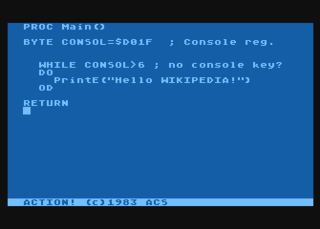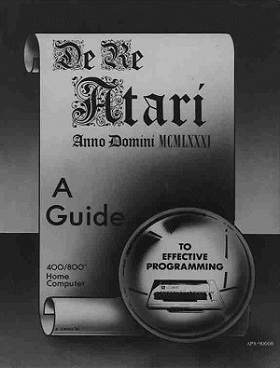Related Research Articles

The MOS Technology 6502 is an 8-bit microprocessor that was designed by a small team led by Chuck Peddle for MOS Technology. The design team had formerly worked at Motorola on the Motorola 6800 project; the 6502 is essentially a simplified, less expensive and faster version of that design.

The Atari 8-bit computers, formally launched as the Atari Home Computer System, are a series of 8-bit home computers introduced by Atari, Inc. in 1979 with the Atari 400 and Atari 800. It is the first home computer architecture with coprocessors, enabling more advanced graphics and sound than most of its contemporaries. Video games are key to its software library, and the 1980 first-person space combat simulator Star Raiders is considered the platform's killer app.

Atari BASIC is an interpreter for the BASIC programming language that shipped with Atari 8-bit computers. Unlike most American BASICs of the home computer era, Atari BASIC is not a derivative of Microsoft BASIC and differs in significant ways. It includes keywords for Atari-specific features and lacks support for string arrays.
Integer BASIC is a BASIC interpreter written by Steve Wozniak for the Apple I and Apple II computers. Originally available on cassette for the Apple I in 1976, then included in ROM on the Apple II from its release in 1977, it was the first version of BASIC used by many early home computer owners.
Commodore BASIC, also known as PET BASIC or CBM-BASIC, is the dialect of the BASIC programming language used in Commodore International's 8-bit home computer line, stretching from the PET (1977) to the Commodore 128 (1985).
The Atari Microsoft BASIC and Atari Microsoft BASIC II variants of the 6502-version of Microsoft BASIC ported to the Atari 8-bit computers. The first version, released 1981, required 32 KB of RAM and was supplied on floppy disk. The second version, released the next year, had most of the code on a ROM cartridge with additional functions on an optional floppy.

Action! is a procedural programming language and integrated development environment written by Clinton Parker for the Atari 8-bit computers. The language, which is similar to ALGOL, compiles to high-performance code for the MOS Technology 6502 of the Atari computers. Action! was distributed on ROM cartridge by Optimized Systems Software starting in 1983. It was one of the company's first bank-switched 16 kB "Super Cartridges". The runtime library is stored in the cartridge; to make a standalone application requires the Action! Toolkit which was sold separately by OSS.

Turbo-BASIC XL is an enhanced version of the BASIC programming language for Atari 8-bit computers. It is a compatible superset of the Atari BASIC that shipped with the Atari 8-bit systems. Turbo-Basic XL was developed by Frank Ostrowski and published in the December 1985 issue of German computer magazine Happy Computer. A version for the 400/800 models was released shortly after as Frost Basic 1.4. Several modified versions working with different DOS systems have been released by other authors.

The Western Design Center (WDC) 65C02 microprocessor is an enhanced CMOS version of the popular nMOS-based 8-bit MOS Technology 6502. It uses less power than the original 6502, fixes several problems, and adds new instructions. The power usage is on the order of 10 to 20 times less than the original 6502 running at the same speed; its reduced power consumption has made it useful in portable computer roles and industrial microcontroller systems. The 65C02 has also been used in some home computers, as well as in embedded applications, including medical-grade implanted devices.
Optimized Systems Software (OSS) was a company that produced disk operating systems, programming languages with integrated development environments, and applications primarily for Atari 8-bit computers. The founders of OSS previously developed Atari DOS, Atari BASIC, and the Atari Assembler Editor for Atari, Inc., and many OSS products are substantially improved versions. OS A+ and DOS XL are based on Atari DOS. BASIC A+, BASIC XL, and BASIC XE are based on Atari BASIC. EASMD and MAC/65 are modeled on the Atari Assembler Editor. Action! is an ALGOL-inspired compiled programming language with an integrated full-screen editor. OSS also sold some software for the Apple II.
Shepardson Microsystems, Inc. (SMI) was a small company producing operating systems and programming languages for CP/M, the Atari 8-bit family and Apple II computers. SMI is most noted for the original Apple II disk operating system, Atari BASIC, and Atari's disk operating system. Shepardson Microsystems was founded by Robert Shepardson in Saratoga Springs, New York.

The Machine Operating System (MOS) or OS is a discontinued computer operating system (OS) used in Acorn Computers' BBC computer range. It included support for four-channel sound, graphics, file system abstraction, and digital and analogue input/output (I/O) including a daisy-chained expansion bus. The system was single-tasking, monolithic and non-reentrant.

CBASIC is a compiled version of the BASIC programming language written for the CP/M operating system by Gordon Eubanks in 1976–1977. It is an enhanced version of BASIC-E.
The 65xx family of microprocessors, consisting of the MOS Technology 6502 and its derivatives, the WDC 65C02, WDC 65C802 and WDC 65C816, and CSG 65CE02, all handle interrupts in a similar fashion. There are three hardware interrupt signals common to all 65xx processors and one software interrupt, the BRK instruction. The WDC 65C816 adds a fourth hardware interrupt—ABORT, useful for implementing virtual memory architectures—and the COP software interrupt instruction, intended for use in a system with a coprocessor of some type.

Many games, utilities, and educational programs were available for Atari 8-bit computers. Atari, Inc. was primarily the publisher following the launch of the Atari 400/800 in 1979, then increasingly by third parties. Atari also distributed "user written" software through the Atari Program Exchange from 1981 to 1984. After APX folded, many titles were picked up by Antic Software.

De Re Atari, subtitled A Guide to Effective Programming, is a book written by Atari, Inc. employees in 1981 and published by the Atari Program Exchange in 1982 as an unbound, shrink-wrapped set of three-holed punched pages. It was one of the few non-software products sold by APX. Targeted at developers, it documents the advanced features of the Atari 8-bit computers and includes ideas for how to use them in applications. The information in the book was not available in a single, collected source at the time of publication.

GNUSim8085 is a graphical simulator, assembler and debugger for the Intel 8085 microprocessor in Linux and Windows. It is among the 20 winners of the FOSS India Awards announced on February, 2008. GNUSim8085 was originally written by Sridhar Ratnakumar in fall 2003 when he realized that no proper simulators existed for Linux. Several patches, bug fixes and software packaging have been contributed by the GNUSim8085 community. GNUSim8085 users are encouraged to contribute to the simulator through coding, documenting, testing, translating and porting the simulator.

SpartaDOS X is a disk operating system for the Atari 8-bit family of computers that closely resembles MS-DOS. It was developed and sold by ICD, Inc. in 1987-1993, and many years later picked up by the third-party community SpartaDOS X Upgrade Project, which still maintains the software.

MAC/65 is a 6502 assembler written by Stephen D. Lawrow for the Atari 8-bit family of home computers. MAC/65 was first released on disk by Optimized Systems Software in 1982, with the program requiring 16 KB RAM. A bank switched "SuperCartridge" from OSS followed in January 1984 for US$99, occupying only 8 KB.

A BASIC interpreter is an interpreter that enables users to enter and run programs in the BASIC language and was, for the first part of the microcomputer era, the default application that computers would launch. Users were expected to use the BASIC interpreter to type in programs or to load programs from storage.
References
Citations
- ↑ Manual 1981, p. 63.
- ↑ Crawford, Chris (1982). Source Code for Eastern Front (1941). The ATARI Program Exchange.
- ↑ The Creative Atari: Dog Daze and Caverns of Mars. 1983.
- ↑ Crockford, Douglas (1982). Galahad and the Holy Grail Manual (PDF). The ATARI Program Exchange.
- ↑ Ellison, Peter (April 1984). "Interview: Arti Haroutunian". ROM (5): 8.
- 1 2 Hague 2009.
- ↑ Manual 1981, p. 15.
- ↑ Manual 1981, p. 7,31.
- ↑ Manual 1981, p. 31.
- ↑ Manual 1981, pp. 10–12.
- ↑ Manual 1981, pp. 43–44.
- ↑ Manual 1981, p. 25.
- 1 2 Wetmore 1983, p. 29.
- ↑ Manual 1981, p. 35.
- ↑ Manual 1981, p. 41.
- ↑ Manual 1981, pp. 35–41.
- 1 2 3 4 Interview 2015.
- ↑ Wilkinson, Bill (February 1985). "INSIGHT: Atari". Compute!. p. 139.
- ↑ Wilkinson 1982, p. vi.
- ↑ Wilkinson 1982, pp. vi–vii.
- ↑ Ratcliff, Matthew (20 November 1989). "Atari Assembler Editor Reference".
Bibliography
- Atari Assembler Editor User Manual (PDF). Atari. 1981.
- Hague, James (2 August 2009). "A Personal History of Compilation Speed, Part 1". Programming in the 21st Century.
- Kathleen O'Brien, Kevin Savetz (13 March 2015). Kathleen O'Brien, OSS (Podcast).
- Wetmore, Russ (November 1983). "Atari 8-bit assemblers reviewed". Hi-Res. Vol. 1, no. 1.
- Wilkinson, Bill (1982). Inside Atari DOS. Optimized Systems Software, Inc. ISBN 0-942386-02-7 . Retrieved 2009-04-04.